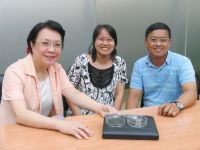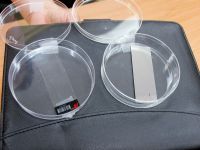“Glycoprotein Synthesis” and “Sugar Chip” development are the major research topics of Dr. Chi-Huey Wong’s group. The team has achieved new breakthroughs on these subjects and published the work in prestigious journals, including “Journal of the American Chemical Society” and “Angewandte Chemie” lately. Their achievements include the development of new sugar chips for drug discovery and assembly of glycoproteins with well defined sugar chain structure.
Glycoprotein Synthesis
Ninety percent of the proteins in our body are glycoprotein, which are proteins coated with all kinds of sugar molecules. It is known that all the antibodies are glycoproteins, and most of infections caused by virus and the spread of cancer are often involved in using a carbohydrate compound to interact with certain glycoprotein receptor. However, the mechanisms of such interactions are still left as a black box. If there is a way to understand it, new drugs may be discovered to benefit patients enormously. The problem is, on a naturally formed glycoprotein, there lie hundreds of different sugar molecules, and how do we find out what each one of these sugars is doing on a glycoprotein?
Wong’s team took a systematic approach to assemble glycopeptide segments into glycoproteins with well defined sugar chain structure; in this way, they can design glycopeptides, modify the sugar moiety and thus make the study of their functions possible.
In the latest publication, the researchers start the work from the synthesis of tagged glycopeptides., i.e.peptides attached with a sugar residue or a sugar chain where a handle (ie the mercaptoacetyl group) is linked to the amine or a hydroxyl on the first sugar directly bound to the peptide. Then, a magical chemical reaction makes it possible to assemble these glycopeptides one by one, and finally into a large glycoprotein with one or more sugar-chains attached to !
By making it possible to assemble a glycoprotein from glycopeptides, one can modify the sugar component of the glycopeptide to make glycoproteins with variation in the sugar chain and study how the sugar chain affects the structure and function of a glycoprotein. One way of such a study is to use sugar chips to characterize the interaction of a glycoprotein with different sugar ligands on the chip in order to define the binding specificity of the glycoprotein.
Novel Sugar Chips Developed
The glycolipid a-GalCer is a ligand of the CD1d receptor on dendritic cells. After binding to CD1d, the sugar moiety of the glycolipid will interact with natural killer T cells and induce Th1 or Th2 cytokines. Previous studies showed that glycolipids with strong adjuvant activities are also very effective as anticancer agents, and they are more selective toward Th1 (See Note below). To identify glycolipids as effective adjuvants and anticancer agents, it is necessary to develop a method capable of testing the binding of CD1d to label-free glycolipids and find out which glycolipid can most tightly interact with CD1d in order to induce the Th1 pathway..
By conventional method, it’ll take enormous efforts to test α-GalCer analogs one by one. The team decided to turn to the Sugar Chip method, and came up with a “once for all” strategy. By arranging various densities of α-GalCer analogs on the sugar chip and then applying CD1d to the chip surface, they determined the surface dissociation constant which reflects the multivalent interaction between CD1 and the surface glycolipid; the smaller the constant, the tighter the binding force is. Using 4 kinds of analogs on a chip and multiple chips at the same time, they tested out all analogs within two hours and pinpointed a winner. They also used a competition method, by adding a new glycolipid to the chip surface where a-GalCer is bound with CD1d which is then recognized by an anti-CD1d antibody labeled with a fluorescence probe, to determine the monovalent dissociation constant of the new glycolipid-CD1d in solution. The best glycolipid identified in the study has the tightest binding and proved to be 100 times more active than a-GalCer as adjuvant and thus is used as a drug candidate.
Participants of this research from Genomics Research Center(GRC) include first author Dr. Pi-Hui Liang, previously GRC postdoctoral fellow and now Assistant Professor in School of Pharmacy in National Taiwan University, and Mr. Bing-Ching Wu, a graduate student.
Since sugar chip has proven to be an effective tool for research and has a promising potential to be used as diagnostic tool clinically, a good quality control method in the production line becomes the prerequisite.
Currently, the sugar chips used in the lab are mostly glass slides. It is, however, difficult to characterize the chip if the sugars are covalently linked to the surface. To solve this problem,
the team came up with a way to coat a thin layer of aluminum on the glass slide and attach a sugar covalently to the aluminum surface through a photocleavable spacer group. When characterized by a mass spectrometer, the laser beam from the mass spectrometer will cleave the cleavable bond and release the sugar. With this method, there is no need to use matrix.
The result also showed an increase in sensitivity by 10-fold compared to the use of glass chip. However, the most valuable is that this makes the production of the sugar chip possible since a methodology of quality control is in place. “The interplay between the newly developed sugar chips and glycoprotein synthesis will be an exciting approach to uncover many mysteries in the field of post-translational glycosylation and lead to a new direction of drug discovery”, said Wong.
Major participants of this research include Dr. Chung-Yi Wu, an Assistant Research Fellow of the Genomics Research Center, postdoctoral research fellow Dr. Susan Tseng, and GRC Director Dr. Winston Chung-Hsuan Chen.
The details of these works can be found online of the following websites :
Glycoprotein Synthesis
1. “Sugar-Assisted Glycopeptide Ligation with Complex Oligosaccharides: Scope and Limitations” J. Am. Chem. Soc. 2008, Aug 13, ASAP.
http://pubs.acs.org/cgi-bin/abstract.cgi/jacsat/asap/abs/ja8010513.html
2. “Cysteine-Free Peptide and Glycopeptide Ligation by Direct Aminolysis” Angew. Chem. Int. Ed. 2008, 47, 4411-4415
http://www3.interscience.wiley.com/cgi-bin/fulltext/118934358/PDFSTART
Novel Sugar Chips Developed
1. “Quantitative Microarray Analysis of Intact Glycolipid−CD1d Interaction and Correlation with Cell-Based Cytokine Production”J. Am. Chem. Soc. 2008, Aug 20, ASAP
http://pubs.acs.org/cgi-bin/abstract.cgi/jacsat/asap/abs/ja8012787.html
2. “Glycan Arrays on Aluminum-Coated Glass Slides”Chemistry - an Asian Journal 2008, Aug 5. ASAP.
http://www3.interscience.wiley.com/cgi-bin/fulltext/121370710/PDFSTART
**Note: CD1d and α-GalCer analogs**
In a series of studies, researches in the Genomics Research Center have already identified the effectiveness of α-GalCer analogs.
CD1d is a glycoprotein expressed on the surface of various human antigen-presenting cells, called dendritic cells. By getting hold of the glycolipid and making an alliance with Natural Killer T-cells (NKT) the same time, the combined CD1-Glycolipid-NKT complex induces two kinds of cytokines, through Th1 and Th2 pathways. Th1 proved to help our immune systems to fight against intruders like cancer cells and viruses, yet Th2 tends to suppress the immune system and reduces the burden of auto-immune diseases like diabetes, lupus, and rheumatoid arthritis.
Therefore, the goal of developing effective adjuvants or anticancer agents is to identify glycolipids as CD1d ligands to activate NKT cells and induce the Th1 pathway more selectively.
Existing study showed that during the interaction of the glycolipid, NKT and CD1d, a seesaw struggle took place. When loosely connected, Th2 cytokines are released, when the binding force seemed to be stable and strong, a large quantity of Th1 cytokines is released. Therefore, the goal is “to find the α-GalCer analog that can get hold of CD1d the longest and tightest.”

